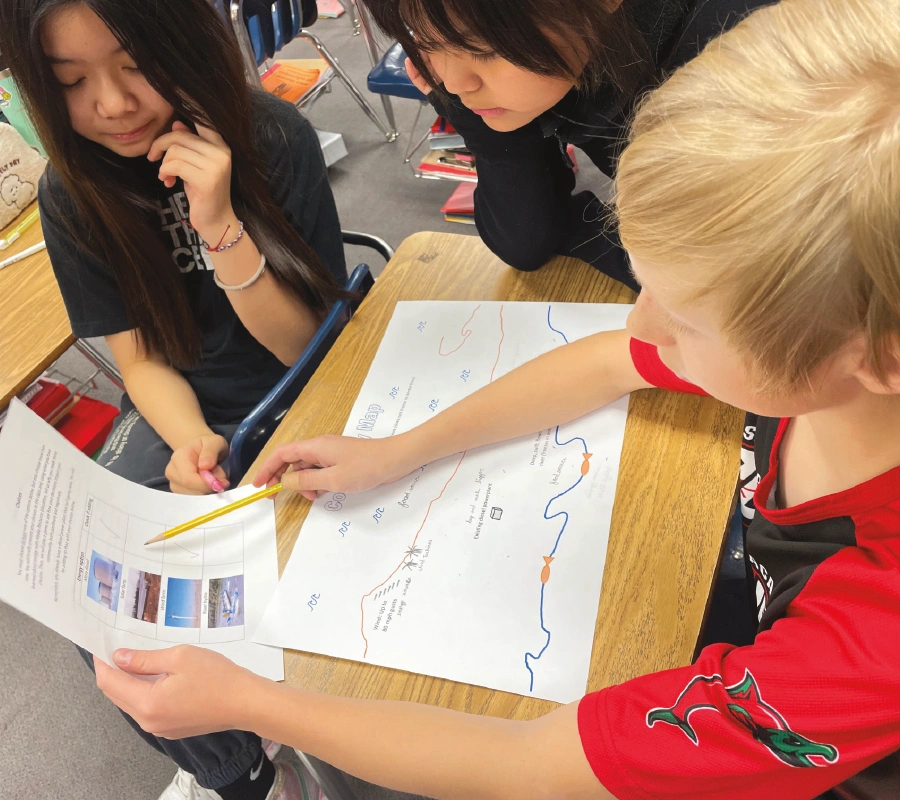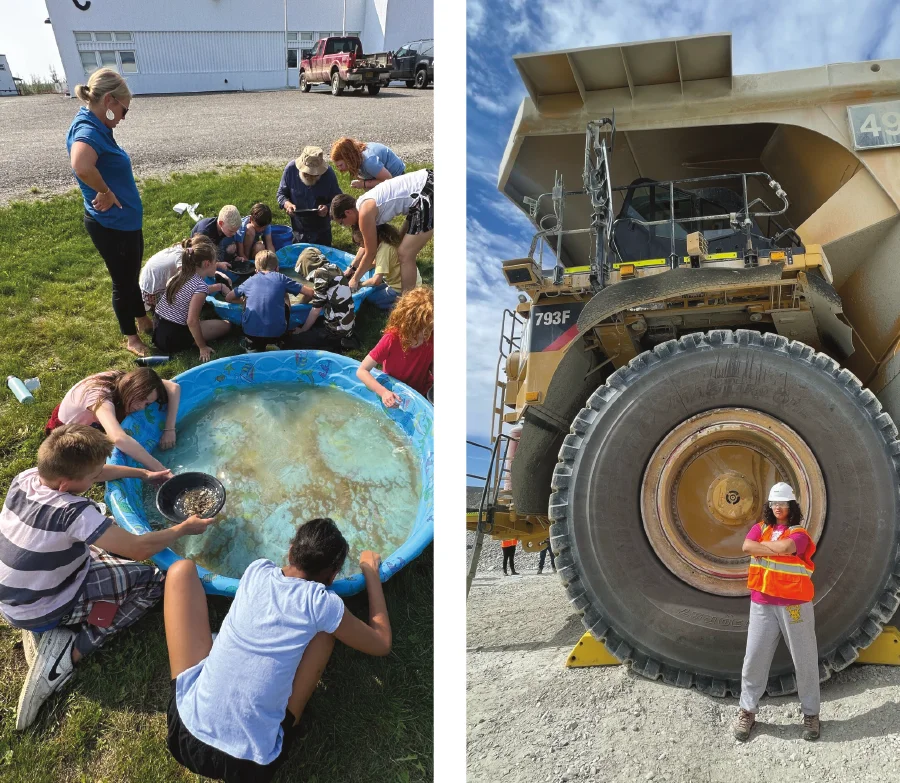hildren are Alaska’s most precious resource, everyone can agree. The state’s other resources—be they oil and gas, minerals, forests, or energy—present young people with career opportunities. One way that students learn about these resources and careers is through Alaska Resource Education (ARE), an award-winning nonprofit that connects children with the major industries that Alaska depends on.
Founded in 1982, ARE is funded through state, corporate, and individual donations. The 501(c)(3) organization is a partnership between the Alaska Department of Education and Early Development and private companies. ARE provides educational opportunities for students and teachers statewide, distributing a primary education curriculum that meets state standards for science, technology, engineering, and math. The curriculum also aligns with core language arts standards.
“Our partnership with Alaska Resource Education has led to incredible STEM-based learning opportunities that ultimately teach our students about the many careers in our state’s environmental resources,” notes Conrad Woodhead in a testimonial on the organization’s website. Woodhead is the residential director for Kusilvak Career Academy, a school in Anchorage operated by the Lower Yukon School District.
Perhaps what matters most is what ARE does for the students. “ARE’s class changed my life and showed me that life is so much more than the straightforward path we are taught in school every day,” shares Taylor Stewart from Service High School in Anchorage. “My experience with ARE has shown me that life is full of possibilities and that it is okay and completely expected to not know what the rest of your life looks like.”
“We have three program levels,” explains ARE program director Beki Toussaint. “The Spark program, which includes up to three contact hours with students; the Ignite program, which includes up to four contact hours; and the Launch program for high school aged students, which helps them make connections enabling students to launch into the next stage of their lives, whether that is college or on-the-job training programs.”
ARE exists to give educators the tools they need to provide students of all ages with engaging and educational opportunities. Toussaint says, “We teach through a wide range of methods including classroom visits, summer camps, teacher training, and youth programs.”
ARE takes its program to any school that extends an invitation, whether that means traveling to rural Alaska or doing online video meetings. “For Zoom classroom visits, we ship materials ahead of time and then set up a Zoom meeting with the teacher to go over the program,” says Toussaint, adding that ARE has an educator in Fairbanks who covers the Interior—at least, everything on the road system.
For forestry classes, students simulate consumption, recycling, renewal, and conservation of wood products using simple items like lima beans. Students also learn about the life cycle of a tree, which is one of the best ways to learn about trees. As a tree goes from birth to death, its physical form changes, as well as its role in the forest ecosystem.
ARE’s teaching methods about forestry include active participation where teachers ask young students to imitate their movements as they enact the life of a tree. For example, curl up in a tight ball to become a seed. Next, uncurl and kneel to mimic the sprouting of the tree. Then stick one arm up with a curled fist to indicate the growth of a limb. Wiggling toes indicates the growth of lots of little roots or rootlets. When the teacher makes a knocking noise, students learn about woodpeckers pecking into the tree’s dead wood.

Alaska Resource Education
“Students absolutely love our programming,” says Toussaint. “It’s hands-on. It’s interactive and engaging with some level of competition. We even have them drill for oil in cupcakes!”
Oil and gas lessons go beyond taste tests, though, by including instruction in the processes of leasing, exploring, and planning.
“In the past couple of years, we’ve shifted our focus to workforce development, encouraging students to stay and work in Alaska,” Toussaint says.
ARE embarked on a mission to empower Alaskan girls to become the next generation of women leaders. Through its Powerful Opportunities for Women in Resources (POWR) program, ARE enlightens high school girls from across the state about potential careers in the natural resource industry.
“Many of the jobs in the natural resource industry have the stigma that they’re for the boys,” shares Toussaint. “We bring in women from across all of the industries to talk to the girls about crossing the boundaries and dispelling that myth.”
Through POWR, ARE encourages the girls to become innovative problem solvers and help tackle the big problems, all while staying in Alaska.
ARE leads this exploration each spring at King Tech High School in Anchorage through the “third session” after-school program, which runs Monday through Thursday from 3 pm to 5 pm. Upon completion, students earn a 0.5 elective science credit.
“Each day we will introduce a new topic and then bring in a woman working in that career,” explains Toussaint. “For the mining industry, we could bring in a geologist, a blaster, heavy equipment operator, or a woman in environmental services.”
The program has been a momentous success for the high school girls who have attended. “We have girls who are struggling or even failing other classes who are getting A and B grades in this class,” shares Toussaint. “POWR is applicable, supported, and different from anything they’ve experienced.”
There is an optional five-day field trip in the summer, touring resource sites across the state. “We take a subset of the girls who want to go and allow them to see everything they learned about,” explains Toussaint.
In prior years, the POWR girls have visited a coal mine, a gold mine, a solar farm, a hydro research facility, a satellite lab, a large animal research facility, and more. The group travels by bus and stays in hotels and at partner facilities during the trip. ARE covers all expenses.
Field trips have proven to be a game changer for many of the girls. “One of our students became interested in carpentry and decided to study carpentry in college,” shares Toussaint. “She’s buying carpentry tools with her college scholarship and moving from cheerleader to carpenter.”
In addition to the Anchorage program this spring, ARE will offer a POWR camp at the UAS Technical Education Center in Juneau later this year.
Another program expansion is aimed northwest. “Last year we piloted a program called ‘ARE Rockstars’ focused on mining,” says Toussaint. “This year we’re developing a version of that in the Bering Straits region and will be bringing students to NACTEC [Northwestern Alaska Career and Technical Center] in Nome to do an entire class on the entry-level careers in the mining industry.”
“We do get those questions sometimes,” shares Toussaint. “We get financial support from the mining industry and the oil and gas industry and, as a result, people do have some concerns that it is propaganda. But the reality is, we create a science-based and fact-based curriculum to teach about Alaska’s resource industries. We do not teach pro- or anti-anything, and we welcome people to join us in the classroom where they can see the workshops.”

Alaska Resource Education

The organization also garnered other acknowledgements. For instance, ARE’s assistant program director Taylor Burgh received the Rising Star award last year from the Alaska Oil & Gas Association. Burgh is credited with having a transformational impact on oil and gas education, quickly rising through the ARE ranks, and spearheading initiatives such as POWR. She also teaches that resource development coexists with environmental protection.
“The passion and caliber of the instruction provided by the staff at ARE—all of which have vast industry, teaching, and Alaska experience—help them connect with our students in a way that is not easily replicated,” says Woodhead. “They are patient, operate through a cultural lens, and help advocate on behalf of our program with other potential partnerships, which can lead to several post-secondary training programs and careers. Our program would not be as strong without our relationship with ARE.”
Service High culinary arts teacher Melinda Moore agrees. “Alaska Resource Education provides students with the opportunity to touch, see, and apply natural resources to real-life applications,” she says in her testimonial. “My favorite is when students design and construct solar-powered boats and race them in a kiddie pool. It’s amazing, engaging, and educational!”
Furthermore, ARE’s reach goes beyond children to include continuing education at the college level. One program introduces adults to sustainable resource systems and renewable energy, as a framework for teaching the topic. Another course, Rock & Roll Around Alaska, facilitates field trips to industrial sites so teachers gain concrete experience with the abstract topics in the lesson plans.
The courses are certified by the UA System to qualify for a continuing education credit. In effect, ARE is teaching adults how to do what the organization itself does: inspire through scientific and career-centered activities.